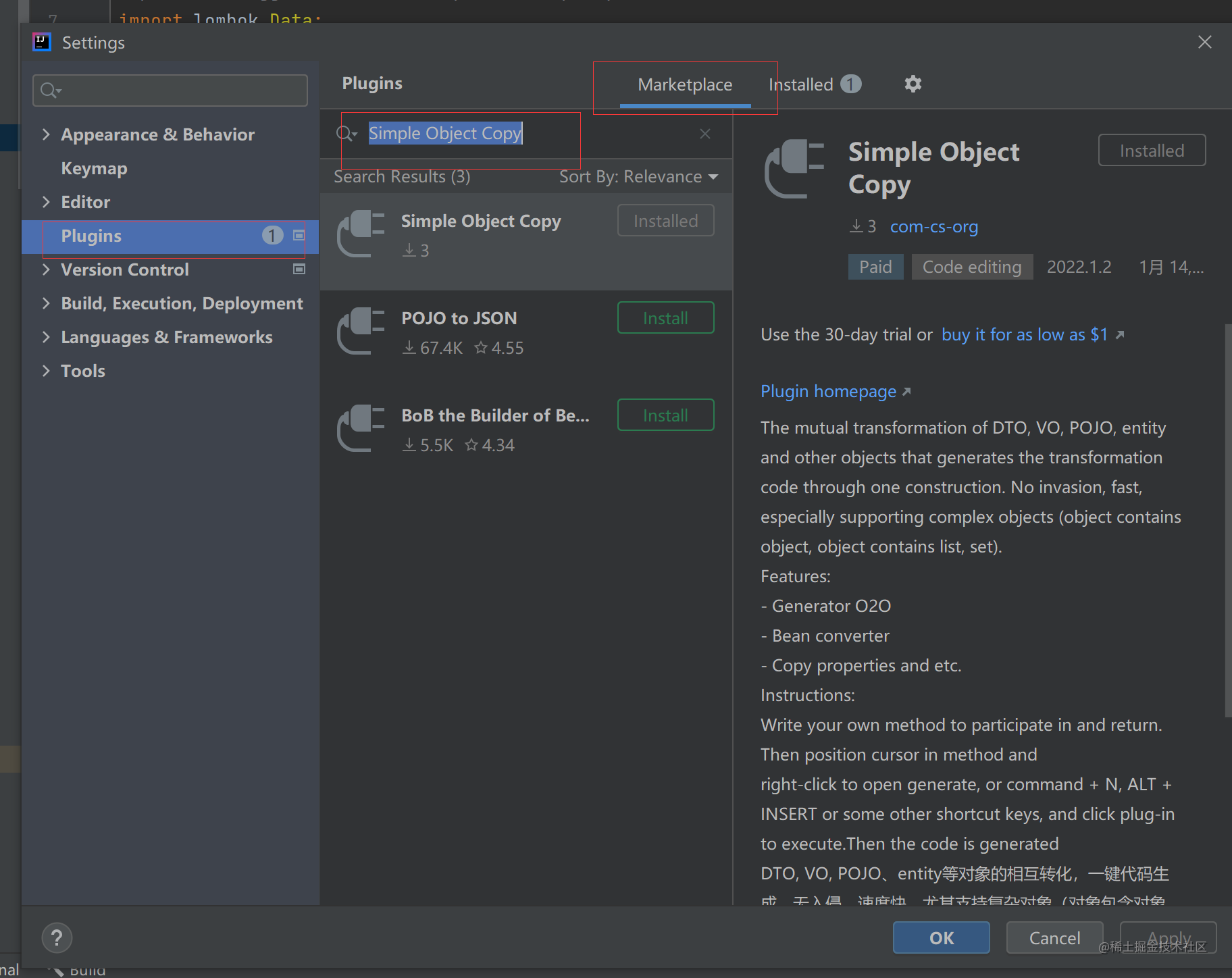1、什么是DTO、VO、BO、PO、DO、POJO
POJO的定义是无规则简单的对象,在日常的代码分层中pojo会被分为VO、BO、 PO、 DTO
VO (view object/value object)表示层对象
1、前端展示的数据,在接口数据返回给前端的时候需要转成VO
2、个人理解使用场景,接口层服务中,将DTO转成VO,返回给前台
B0(bussines object)业务层对象
1、主要在服务内部使用的业务对象
2、可以包含多个对象,可以用于对象的聚合操作
3、个人理解使用场景,在服务层服务中,由DTO转成BO然后进行业务处理后,转成DTO返回到接口层
PO(persistent object)持久对象
1、出现位置为数据库数据,用来存储数据库提取的数据
2、只存储数据,不包含数据操作
3、个人理解使用场景,在数据库层中,获取的数据库数据存储到PO中,然后转为DTO返回到服务层中
DTO(Data Transfer Object)数据传输对象
1、在服务间的调用中,传输的数据对象
2、个人理解,DTO是可以存在于各层服务中(接口、服务、数据库等等)服务间的交互使用DTO来解耦
DO(domain object)领域实体对象
DO 现在主要有两个版本:
①阿里巴巴的开发手册中的定义,DO( Data Object)这个等同于上面的PO
②DDD(Domain-Driven Design)领域驱动设计中,DO(Domain Object)这个等同于上面的BO
参考文档:
https://juejin.cn/post/6952848675924082718
https://juejin.cn/post/6844904046097072141
https://zhuanlan.zhihu.com/p/2646753952、插件如何完成转化
插件名称:Simple Object Copy
- 定义方法出入参
- 光标定位方法内,使用快捷键ALT+INSERT(WIN) 、 command + N(mac) ,或者右键鼠标选择Generate,弹出生成选项框后,选择genCopyMethod,代码就生成好了


复杂对象转化展示

@Data
public class UserVO {
private String name;
private Date entryDate;
private String userId;
private List<RoleVO> roleList;
private RoomVO room;
public static UserVO convertToUserVO(UserDTO item) {
if (item == null) {
return null;
}
UserVO result = new UserVO();
result.setName(item.getName());
result.setEntryDate(item.getEntryDate());
result.setUserId(item.getUserId());
List<RoleDTO> roleList = item.getRoleList();
if (roleList == null) {
result.setRoleList(null);
} else {
result.setRoleList(roleList.stream().map(UserVO::convertToRoleVO).collect(Collectors.toList());
}
result.setRoom(convertToRoomVO(item.getRoom()));
return result;
}
public static RoomVO convertToRoomVO(RoomDTO item) {
if (item == null) {
return null;
}
RoomVO result = new RoomVO();
result.setRoomId(item.getRoomId());
result.setBuildingId(item.getBuildingId());
result.setRoomName();
result.setBuildingName();
return result;
}
public static RoleVO convertToRoleVO(RoleDTO item) {
if (item == null) {
return null;
}
RoleVO result = new RoleVO();
result.setRoleId(item.getRoleId());
result.setRoleName(item.getRoleName());
result.setCreateTime(item.getCreateTime());
return result;
}
}
@Data
public class UserDTO {
private String name;
private Date entryDate;
private String userId;
private List<RoleDTO> roleList;
private RoomDTO room;
}
@Data
public class RoleVO {
private String roleId;
private String roleName;
private LocalDateTime createTime;
}
@Data
public class RoleDTO {
private String roleId;
private String roleName;
private LocalDateTime createTime;
}
@Data
public class RoomVO {
private String roomId;
private String buildingId;
private String roomName;
private String buildingName;
}
@Data
public class RoomDTO {
private String roomId;
private String buildingId;
}3、其他转化方式
1.无入侵 市面上有很多类似的工具类,比较常用的有
- 1、Spring BeanUtils (copyProperties)
- 2、Cglib BeanCopier (copyProperties)
- 3、Apache BeanUtils (copyProperties)
- 4、Apache PropertyUtils (copyProperties)
- 5、Dozer
- 6、mapstruct
- 7、JSON 序列化 再反序列化
这些工具,不仅要引入相应的依赖jar包,而且对代码有入侵,要调用对应得api方法才能进行转化,一旦遇到类型不一致,字段名稍有变动,就需要另写java代码补全字段,整体代码非常丑陋。
举例:
1.mapstruct
同样的代码,,不仅要引入依赖、写如下转化mapper,还要,在对应地方调用对应api(代码入侵验证),然而Simple Object Copy 只需要一键生成。
RoomDTO中不存在的roomName、buildingName还要mapstruct另写方法,很容易忽略。源实体中不存在的属性,没有提示,小心前端总是问为啥都是null。
在Simple Object Copy 插件代码生成后,不存在的字段也生成了空方法,直接编译提示补充,不容易忽略
需要手写的代码:
@Mapper(componentModel = "spring",uses = {RoleVOMapper.class,RoomVOMapper.class})
public interface UserMapper {
UserConverter INSTANCE = Mappers.getMapper(UserConverter.class);
UserVO toUserVO(UserDTO userDTO);
}
@Mapper(componentModel = "spring")
public interface RoleMapper {
RoleVO toRoleVO(RoleDTO roleDTO);
}
@Mapper(componentModel = "spring")
public interface RoomMapper {
RoomVO toRoomVO(RoomDTO roomDTO);
}
//调用示例
public class Main {
public static void main(String[] args) {
UserDTO user = ;
UserVO userVO = UserMapper.INSTANCE.toUserVO(user);
userVO.getRoomVO().setRoomName("大厅1");
userVO.getRoomVO().setBuildingName("尚德楼");
}
}
2.BeanUtils
性能稍差。
不支持复杂对象还是要写大量代码,代码字段不清晰不易理解,别人接手难。
RoomDTO中不存在的roomName、buildingName还要BeanUtils另写方法,很容易忽略。源实体中不存在的属性,没有提示,小心前端总是问为啥都是null。
需要手写的代码
@Data
public class UserVO {
private String name;
private Date entryDate;
private String userId;
private List<RoleVO> roleList;
private RoomVO room;
public static UserVO convertToUserVO(UserDTO item) {
if (item == null) {
return null;
}
UserVO result = new UserVO();
BeanUtils.copyProperties(item,result);
List<RoleDTO> roleList = item.getRoleList();
if (roleList == null) {
result.setRoleList(null);
} else {
result.setRoleList(roleList.stream().map(UserVO::convertToRoleVO).collect(Collectors.toList());
}
result.setRoom(convertToRoomVO(item.getRoom()));
return result;
}
public static RoomVO convertToRoomVO(RoomDTO item) {
if (item == null) {
return null;
}
RoomVO result = new RoomVO();
BeanUtils.copyProperties(item,result);
//这里没有代码提示,需要自己写,小心前端总是问为啥都是null
result.setRoomName();
result.setBuildingName();
return result;
}
public static RoleVO convertToRoleVO(RoleDTO item) {
if (item == null) {
return null;
}
RoleVO result = new RoleVO();
BeanUtils.copyProperties(item,result);
return result;
}
}
2.性能优势
相比上面的工具类,不是使用反射、就是是用代理、序列化操作。相比于纯正的set方法去转化,差距不是一个量级。此次不赘述。
3.灵活性、兼容性
跟上述工具类相比插件有很大优势,不再赘述,下面我们比较一下,我之前常用的idea插件generateO2O
| 我方插件 | 特点 | 对比插件 | 特点 |
|---|---|---|---|
| Simple Object Copy | 依据返回值为主,根据字段名去匹配 ,不会导致返回值漏属性 | generateO2O | 以入参为主匹配字段,存在漏属性的情况 |
| Simple Object Copy | 支持对象包含对象、对象包含list、set集合的转化 | generateO2O | 不支持子对象的转化、不支持list泛型不同的转化 |
| Simple Object Copy | 相同出入参类名,生成全限定类名 | generateO2O | 同类名出现问题 |
在此推荐其他一个我常用插件:generateAllSetter,搭配食用更佳
4、如何下载
打开idea plugins,切market place 搜索:Simple Object Copy

试用30天,支付宝、微信、PayPal都可以付款。 6元(人民币)每年,当然学生、教育机构、公益免费。
官方会邮件让你注册jb账号,给账号开通权限,你可以在官网找到自己的激活码,然后再idea 不登录用。也可以在idea 登录jb账号在线试用。
这可能是你的第一个付费插件。多谢支持,哈哈!
如果你没钱的话,也可邮件我。993198101@qq.com
下班早一半
通过插件的使用
1、可以节省一个个字段的设置的开发时间
2、避免了漏字段设置,ps:前端同学总是来问为啥字段总是null。
3、而且通过出入参的设计思想去开发,规范了代码,在有特殊请求转化的时候也比较方便。









